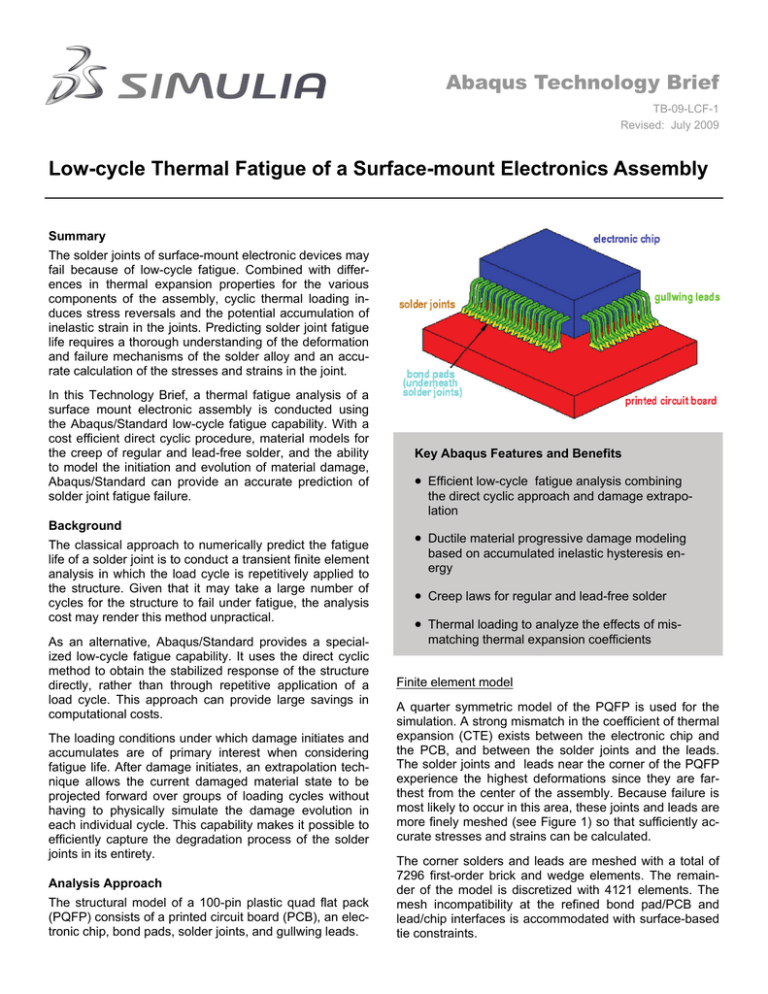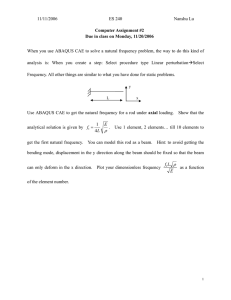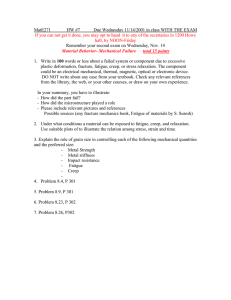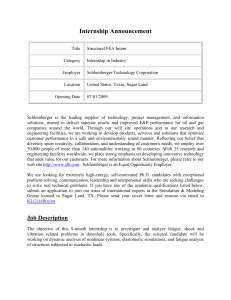Abaqus Technology Brief Low-cycle Thermal Fatigue of a Surface-mount Electronics Assembly
advertisement

Abaqus Technology Brief TB-09-LCF-1 Revised: July 2009 Low-cycle Thermal Fatigue of a Surface-mount Electronics Assembly Summary The solder joints of surface-mount electronic devices may fail because of low-cycle fatigue. Combined with differences in thermal expansion properties for the various components of the assembly, cyclic thermal loading induces stress reversals and the potential accumulation of inelastic strain in the joints. Predicting solder joint fatigue life requires a thorough understanding of the deformation and failure mechanisms of the solder alloy and an accurate calculation of the stresses and strains in the joint. In this Technology Brief, a thermal fatigue analysis of a surface mount electronic assembly is conducted using the Abaqus/Standard low-cycle fatigue capability. With a cost efficient direct cyclic procedure, material models for the creep of regular and lead-free solder, and the ability to model the initiation and evolution of material damage, Abaqus/Standard can provide an accurate prediction of solder joint fatigue failure. Background The classical approach to numerically predict the fatigue life of a solder joint is to conduct a transient finite element analysis in which the load cycle is repetitively applied to the structure. Given that it may take a large number of cycles for the structure to fail under fatigue, the analysis cost may render this method unpractical. As an alternative, Abaqus/Standard provides a specialized low-cycle fatigue capability. It uses the direct cyclic method to obtain the stabilized response of the structure directly, rather than through repetitive application of a load cycle. This approach can provide large savings in computational costs. The loading conditions under which damage initiates and accumulates are of primary interest when considering fatigue life. After damage initiates, an extrapolation technique allows the current damaged material state to be projected forward over groups of loading cycles without having to physically simulate the damage evolution in each individual cycle. This capability makes it possible to efficiently capture the degradation process of the solder joints in its entirety. Analysis Approach The structural model of a 100-pin plastic quad flat pack (PQFP) consists of a printed circuit board (PCB), an electronic chip, bond pads, solder joints, and gullwing leads. Key Abaqus Features and Benefits Efficient low-cycle fatigue analysis combining the direct cyclic approach and damage extrapolation Ductile material progressive damage modeling based on accumulated inelastic hysteresis energy Creep laws for regular and lead-free solder Thermal loading to analyze the effects of mismatching thermal expansion coefficients Finite element model A quarter symmetric model of the PQFP is used for the simulation. A strong mismatch in the coefficient of thermal expansion (CTE) exists between the electronic chip and the PCB, and between the solder joints and the leads. The solder joints and leads near the corner of the PQFP experience the highest deformations since they are farthest from the center of the assembly. Because failure is most likely to occur in this area, these joints and leads are more finely meshed (see Figure 1) so that sufficiently accurate stresses and strains can be calculated. The corner solders and leads are meshed with a total of 7296 first-order brick and wedge elements. The remainder of the model is discretized with 4121 elements. The mesh incompatibility at the refined bond pad/PCB and lead/chip interfaces is accommodated with surface-based tie constraints. 2 Figure 2: One thermal loading cycle Figure 1: PQFP mesh, with refinement in corner legs Material models The elastic behavior of the solder is modeled with a temperature-dependent modulus of elasticity. The solder’s inelastic response is characterized by the double-power creep model of Wiese [1], and is documented in Abaqus Answer 3049. The Abaqus/Standard damage initiation and evolution model for low-cycle fatigue analysis is characterized by the amount of inelastic hysteresis energy accumulated per stabilized loading cycle. The other components of the PQFP are assumed to behave as linear elastic, with temperature-independent properties. This assumption allows the option of modeling the entire PQFP, apart from the two corner solders and leads, as a single substructure. Although not taken in the present simulation, this approach can further reduce the size and cost of the analysis. Loading and analysis procedure The PQFP is subject to a thermal loading cycle that is illustrated in Figure 2. It consists of uniform heating from 0°C to 125°C, holding at 125°C, cooling uniformly from 125°C to 0°C, and holding at 0°C. Heating and cooling are performed linearly over 1 minute, while holding periods are 15 minutes in duration. The PQFP is assumed to be initially stress-free at a reference temperature of 0°C. The entire loading history consists of 801 applications of the thermal cycle. The low-cycle fatigue analysis combines the direct cyclic capability with a damage extrapolation technique. The direct cyclic procedure uses a combination of Fourier Series and time integration of the nonlinear material behavior to directly compute a stabilized state in which the stress-strain relationship in each successive cycle is the same. If the damage initiation criterion is satisfied at any material point at the end of a stabilized cycle, the damage state is extrapolated forward to the next solution increment over a user-chosen number of cycles; for this analysis, the forward extrapolation was done over 50 cycles. The stabilized solution is then determined, the damage state extrapolated to the next increment, and the process repeats. Results As a result of the efficient procedures, the analysis takes only 2353 seconds of CPU time in Abaqus/Standard 6.9-1 with an Intel Xeon CPU of 2.8GHz. The deformation and damage in the solder joints is of greatest interest. Shown in Figure 3 is the deformed shape of the two corner legs after 800 cycles of thermal loading. While the actual deformation is small, the displacements in Figure 3 are magnified 50 times for better visualization. We can see that the legs are twisted at their bases; this is caused by the aforementioned thermal mismatch, i.e., different components of the PQFP having different CTE values. It is also observed in Figure 3 that some of the solder elements have failed. An animation of how the solder joint fails during the course of simulation can be found in Figure 6. Figure 3: Deformed shape of the corner legs 3 Figure 4: Equivalent creep strain history at solder joint toe Figure 5: Mises stress history at solder joint toe Figures 4 and 5 show the equivalent creep strain and Mises stress history plots during cycles 1, 576, and 800 in an element of the “toe” area of the joint, where the maximum creep strain occurs. We can see that the creep strain increases while the stress stays roughly the same in the traces for cycles 1 and 576. The initial dip and subsequent peak in the stress plots are due to the combination of the initial stress state and the competing effects of creep relaxation and CTE mismatch between the PCB and the chip. The stress history in cycle 800 shows the effect of stress re-distribution after degradation; the ele- ments immediately above the element being plotted have completely degraded by cycle 800. Conclusion Reliable estimation of solder joint life in the electronics industry calls for accurate and efficient simulations of lowcycle thermal joint failure in surface mount assemblies. The unique low-cycle fatigue analysis capability and versatile material library of Abaqus/Standard make it an ideal tool for advanced simulations in this field. Figure 6: Development of equivalent creep strain and Mises stress in solder joint (click to animate) 4 References 1. S. Wiese, E. Meusel, and K.J. Wolter, “Microstructural Dependence of Constitutive Properties of Eutectic SnAg and SnAgCu Solders,” 53rd ECTC Conference Proceedings, pp. 197-206, 2003. 2. D. Cadge, “Abaqus for Electronics,” Tutorial at the 2006 Abaqus User Conference Abaqus References For additional information on the Abaqus capabilities referred to in this brief, please see the following Abaqus 6.11 documentation references: Analysis User’s Manual Damage initiation for ductile materials in low-cycle fatigue, Section 23.4.2 Damage evolution for ductile materials in low-cycle fatigue, Section 23.4.3 Low-cycle fatigue analysis using the direct cyclic approach, Section 6.2.7 About SIMULIA SIMULIA is the Dassault Systèmes brand that delivers a scalable portfolio of Realistic Simulation solutions including the Abaqus product suite for Unified Finite Element Analysis, multiphysics solutions for insight into challenging engineering problems, and lifecycle management solutions for managing simulation data, processes, and intellectual property. By building on established technology, respected quality, and superior customer service, SIMULIA makes realistic simulation an integral business practice that improves product performance, reduces physical prototypes, and drives innovation. Headquartered in Providence, RI, USA, with R&D centers in Providence and in Suresnes, France, SIMULIA provides sales, services, and support through a global network of over 30 regional offices and distributors. For more information, visit www.simulia.com The 3DS logo, SIMULIA, Abaqus and the Abaqus logo are trademarks or registered trademarks of Dassault Systèmes or its subsidiaries, which include Abaqus, Inc. Other company, product and service names may be trademarks or service marks of others. Copyright Dassault Systèmes, 2009




